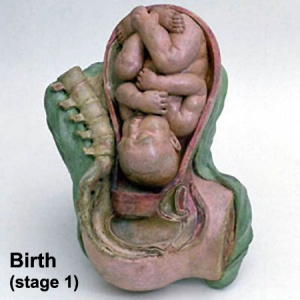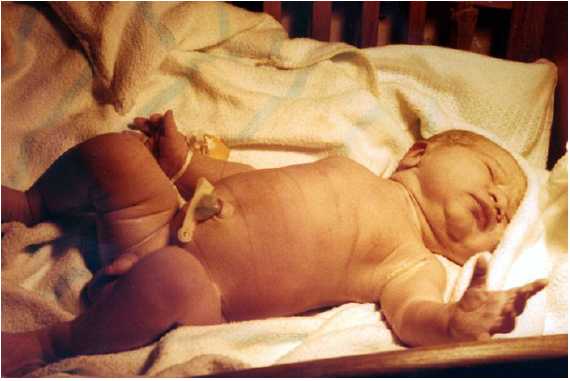2009 Lecture 23: Difference between revisions
No edit summary |
No edit summary |
||
| Line 12: | Line 12: | ||
* The Developing Human: Clinically Oriented Embryology (6th ed.) Moore and Persaud Chapter 7 p129-167 | * The Developing Human: Clinically Oriented Embryology (6th ed.) Moore and Persaud Chapter 7 p129-167 | ||
== Gestation Period == | |||
The median duration of gestation for first births from assumed ovulation to delivery was '''274''' days (just over 39 weeks). For multiple births, the median duration of pregnancy was '''269 '''days (38.4 weeks). | |||
:"...one should count back 3 months from the first day of the last menses, then add 15 days for primiparas or 10 days for multiparas, instead of using the common algorithm for Naegele's rule." Reference: [http://www.ncbi.nlm.nih.gov:80/entrez/query.fcgi?cmd=Retrieve&db=PubMed&list_uids=16547957&dopt=Abstract Mittendorf R, Williams MA, Berkey CS, Cotter PF.] The length of uncomplicated human gestation. Obstet Gynecol. 1990 Jun;75(6):929-32 | |||
Historically, Franz Carl Naegele (1777-1851) developed the first scientific rule for estimating length of a pregnany. | |||
== Preterm Birth == | |||
A study has shown that risks of preterm birth in low abnormal birth weight (intrauterine growth restriction) and high (large for gestational age) categories are 2- to 3-fold greater than the risk among appropriate-for-gestational-age infants. | |||
In another study of placenta previa, low birth weight is due mainly to preterm delivery and to a lesser extent with fetal growth restriction. | |||
Reference: [http://www.ncbi.nlm.nih.gov:80/entrez/query.fcgi?cmd=Retrieve&db=PubMed&list_uids=11303203&dopt=Abstract Lackman F, Capewell V, Richardson B, daSilva O, Gagnon R.] The risks of spontaneous preterm delivery and perinatal mortality in relation to size at birth according to fetal versus neonatal growth standards. Am J Obstet Gynecol. 2001 Apr;184(5):946-53. | |||
[http://www.ncbi.nlm.nih.gov:80/entrez/query.fcgi?cmd=Retrieve&db=PubMed&list_uids=11506849&dopt=Abstract Ananth CV, Demissie K, Smulian JC, Vintzileos AM.] Relationship among placenta previa, fetal growth restriction, and preterm delivery: a population-based study. Obstet Gynecol. 2001 Aug;98(2):299-306. | |||
Revision as of 12:43, 13 October 2009
Birth and Postnatal Development
Introduction
There are a great number of comprehensive, scientific and general, books and articles that cover Parturition, Birth or Childbirth.
Birth or parturition is a critical stage in development, representing in mammals a transition from direct maternal support of fetal development, physical expulsion and establishment of the newborns own respiratory, circulatory and digestive systems.
Textbooks
- Human Embryology (2nd ed.) Larson Chapter 15 p471-488
- The Developing Human: Clinically Oriented Embryology (6th ed.) Moore and Persaud Chapter 7 p129-167
Gestation Period
The median duration of gestation for first births from assumed ovulation to delivery was 274 days (just over 39 weeks). For multiple births, the median duration of pregnancy was 269 days (38.4 weeks).
- "...one should count back 3 months from the first day of the last menses, then add 15 days for primiparas or 10 days for multiparas, instead of using the common algorithm for Naegele's rule." Reference: Mittendorf R, Williams MA, Berkey CS, Cotter PF. The length of uncomplicated human gestation. Obstet Gynecol. 1990 Jun;75(6):929-32
Historically, Franz Carl Naegele (1777-1851) developed the first scientific rule for estimating length of a pregnany.
Preterm Birth
A study has shown that risks of preterm birth in low abnormal birth weight (intrauterine growth restriction) and high (large for gestational age) categories are 2- to 3-fold greater than the risk among appropriate-for-gestational-age infants.
In another study of placenta previa, low birth weight is due mainly to preterm delivery and to a lesser extent with fetal growth restriction.
Reference: Lackman F, Capewell V, Richardson B, daSilva O, Gagnon R. The risks of spontaneous preterm delivery and perinatal mortality in relation to size at birth according to fetal versus neonatal growth standards. Am J Obstet Gynecol. 2001 Apr;184(5):946-53.
Ananth CV, Demissie K, Smulian JC, Vintzileos AM. Relationship among placenta previa, fetal growth restriction, and preterm delivery: a population-based study. Obstet Gynecol. 2001 Aug;98(2):299-306.
Glossary Links
- Glossary: A | B | C | D | E | F | G | H | I | J | K | L | M | N | O | P | Q | R | S | T | U | V | W | X | Y | Z | Numbers | Symbols | Term Link
Course Content 2009
Embryology Introduction | Cell Division/Fertilization | Cell Division/Fertilization | Week 1&2 Development | Week 3 Development | Lab 2 | Mesoderm Development | Ectoderm, Early Neural, Neural Crest | Lab 3 | Early Vascular Development | Placenta | Lab 4 | Endoderm, Early Gastrointestinal | Respiratory Development | Lab 5 | Head Development | Neural Crest Development | Lab 6 | Musculoskeletal Development | Limb Development | Lab 7 | Kidney | Genital | Lab 8 | Sensory - Ear | Integumentary | Lab 9 | Sensory - Eye | Endocrine | Lab 10 | Late Vascular Development | Fetal | Lab 11 | Birth, Postnatal | Revision | Lab 12 | Lecture Audio | Course Timetable
Cite this page: Hill, M.A. (2024, May 18) Embryology 2009 Lecture 23. Retrieved from https://embryology.med.unsw.edu.au/embryology/index.php/2009_Lecture_23
- © Dr Mark Hill 2024, UNSW Embryology ISBN: 978 0 7334 2609 4 - UNSW CRICOS Provider Code No. 00098G

